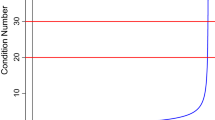Abstract
The description of the collinearity diagnostics as presented in Belsley, Kuh, and Welsch's, Regression Diagnostics: Identifying Influential Data and Sources of Collinearity, is principally formal, leaving it to the user to implement the diagnostics and learn to digest and interpret the diagnostic results. This paper is designed to overcome this shortcoming by describing the different graphical displays that can be used to present the diagnostic information and, more importantly, by providing the detailed guidance needed to promote the beginning user into an experienced diagnostician and to aid those who wish to incorporate or automate the collinearity diagnostics into a guided-computer environment.
Similar content being viewed by others
References
Becker, R., Kaden N, and Klema V, 1974, The singular value analysis in matrix computation, Working Paper 46, Computer Research Center, National Bureau of Economic Research, Cambridge, MA.
Belsley, D.A., 1976, Multicollinearity: diagnosing its presence and assessing the potential damage it causes least-squares estimation, Working Paper #154, Computer Research Center, National Bureau of Economic Research, Cambridge, MA.
Belsley, D.A., 1982, Assessing the presence of harmful collinearity and other forms of weak data through a test for signal-to-noise, J. Econometrics 20, 211–253.
Belsley, D.A., 1984a, Demeaning conditioning diagnostics through centering, with accompanying comments and author's reply, The American Statistician 38, 73–93.
Belsley, D.A., 1984b, Collinearity and forecasting, J. Forecasting 3, 183–196.
Belsley, D.A., 1986, Centering, the constant, first-differencing, and assessing conditioning, in E. Kuh and D.A. Belsley (eds), Model Reliability, MIT Press, Cambridge, MA.
Belsley, D.A., 1987, Comment: Well-conditioned collinearity indices? Statistical Science 2, 86–91.
Belsley, D.A., 1988, Conditioning in models with logs, J. Econometrics 38, 127–143.
Belsley, D. A., 1990, Conditioning Diagnostics: Collinearity and Weak Data in Regression, John Wiley, New York (in press).
Belsley, D.A. and Oldford, W.R., 1986, The general problem of ill conditioning and its role in statistical analysis, Computational Statistics & Data Analysis 4, 103–120.
Belsley, D.A. and Welsch, R.E., 1988, Comment: Modelling energy consumption: Using and abusing regression diagnostics, J. Business and Economic Statistics 6, 442–447.
Belsley, D.A., Kuh, E., and Welsh, R.E., 1980, Regression Diagnostics: Identifying Influential Data and Sources of Collinearity, John Wiley, New York.
Businger, P. and Golub, G.H., 1965, Linear least squares solutions by householder transformations, Numerische Mathematik 7, 269–276.
Golub, G.H., 1969, Matrix decompositions and statistical calculations, R.C. Milton and J.A. Nelder (eds)., Statistical Computation, Academic Press, New York, pp. 365–397.
Golub, G.H. and Reinsch, C., 1970, Singular value decomposition and least-squares solutions, Numerische Mathematik 14, 403–420.
Golub, G.H. and Van Loan, C.F., 1983, Matrix Computations, Johns Hopkins University Press, Baltimore.
Johnston, J., 1984, Econometric Methods, 3rd edn, McGraw-Hill, New York.
Oldford, R.W. and Peters S., 1984, Building a statistical knowledge based system with mini-mycin, Technical Report No. 42, Center for Computational Research in Economics and Management Science, MIT.
Oldford, R.W. and Peters, S., 1985, DINDE: Towards more statistically sophisticated software, Technical Report No. 55, Center for Computational Research in Economics and Management Science, MIT.
Silvey, S.D., 1969, Multicollinearity and imprecise estimation, J. Royal Statistical Society, Series B 31, 539–552.
Stewart, G.W., 1973, Introduction to Matrix Computations, Academic Press, New York.
Theil, H., 1971, Principles of Econometrics, John Wiley, New York.
Author information
Authors and Affiliations
Additional information
This paper was funded in part through a guest scholarship at the Rheinisch-Westfälisches Institut für Wirtschaftsforschung, Essen, West Germany, and in part through NSF Grant SES-8420614.
Rights and permissions
About this article
Cite this article
Belsley, D.A. A Guide to using the collinearity diagnostics. Computer Science in Economics and Management 4, 33–50 (1991). https://doi.org/10.1007/BF00426854
Received:
Issue Date:
DOI: https://doi.org/10.1007/BF00426854




